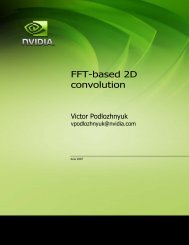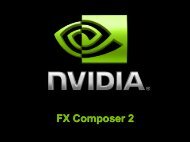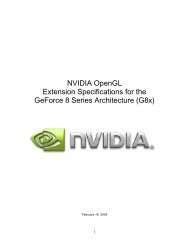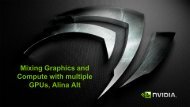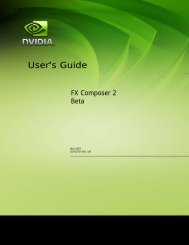Advanced CUDA Webinar Memory Optimizations - Nvidia
Advanced CUDA Webinar Memory Optimizations - Nvidia
Advanced CUDA Webinar Memory Optimizations - Nvidia
Create successful ePaper yourself
Turn your PDF publications into a flip-book with our unique Google optimized e-Paper software.
<strong>Advanced</strong> <strong>CUDA</strong> <strong>Webinar</strong><br />
<strong>Memory</strong> <strong>Optimizations</strong>
Outline<br />
Overview<br />
Hardware<br />
<strong>Memory</strong> <strong>Optimizations</strong><br />
Data transfers between host and device<br />
Device memory optimizations<br />
Summary<br />
Measuring performance – effective bandwidth<br />
Coalescing<br />
Shared <strong>Memory</strong><br />
Textures<br />
© NVIDIA Corporation 2009 2
Optimize Algorithms for the GPU<br />
Maximize independent parallelism<br />
Maximize arithmetic intensity (math/bandwidth)<br />
Sometimes it’s better to recompute than to cache<br />
GPU spends its transistors on ALUs, not memory<br />
Do more computation on the GPU to avoid costly<br />
data transfers<br />
Even low parallelism computations can sometimes be faster<br />
than transferring back and forth to host<br />
© NVIDIA Corporation 2009 3
Optimize <strong>Memory</strong> Access<br />
Coalesced vs. Non-coalesced = order of magnitude<br />
Global/Local device memory<br />
Optimize for spatial locality in cached texture<br />
memory<br />
In shared memory, avoid high-degree bank conflicts<br />
© NVIDIA Corporation 2009 4
Take Advantage of Shared <strong>Memory</strong><br />
Hundreds of times faster than global memory<br />
Threads can cooperate via shared memory<br />
Use one / a few threads to load / compute data<br />
shared by all threads<br />
Use it to avoid non-coalesced access<br />
Stage loads and stores in shared memory to re-order noncoalesceable<br />
addressing<br />
© NVIDIA Corporation 2009 5
Use Parallelism Efficiently<br />
Partition your computation to keep the GPU<br />
multiprocessors equally busy<br />
Many threads, many thread blocks<br />
Keep resource usage low enough to support multiple<br />
active thread blocks per multiprocessor<br />
Registers, shared memory<br />
© NVIDIA Corporation 2009 6
Outline<br />
Overview<br />
Hardware<br />
<strong>Memory</strong> <strong>Optimizations</strong><br />
Data transfers between host and device<br />
Device memory optimizations<br />
Summary<br />
Measuring performance – effective bandwidth<br />
Coalescing<br />
Shared <strong>Memory</strong><br />
Textures<br />
© NVIDIA Corporation 2009 7
10-Series Architecture<br />
240 Scalar Processor (SP) cores execute kernel threads<br />
30 Streaming Multiprocessors (SMs) each contain<br />
8 scalar processors<br />
2 Special Function Units (SFUs)<br />
1 double precision unit<br />
Shared memory enables thread cooperation<br />
Multiprocessor<br />
Double<br />
Shared<br />
<strong>Memory</strong><br />
Scalar<br />
Processors<br />
© NVIDIA Corporation 2009 8
Execution Model<br />
Software Hardware<br />
Thread<br />
Thread<br />
Block<br />
...<br />
Scalar<br />
Processor<br />
Multiprocessor<br />
Grid Device<br />
Threads are executed by scalar processors<br />
Thread blocks are executed on multiprocessors<br />
Thread blocks do not migrate<br />
Several concurrent thread blocks can reside on<br />
one multiprocessor - limited by multiprocessor<br />
resources (shared memory and register file)<br />
A kernel is launched as a grid of thread blocks<br />
Only one kernel can execute on a device at one<br />
time<br />
© NVIDIA Corporation 2009 9
Warps and Half Warps<br />
...<br />
=<br />
32 Threads<br />
32 Threads<br />
32 Threads<br />
Thread<br />
Block Warps Multiprocessor<br />
16<br />
16<br />
Half Warps<br />
DRAM<br />
Global<br />
Local<br />
Device<br />
<strong>Memory</strong><br />
A thread block consists of 32thread<br />
warps<br />
A warp is executed physically in<br />
parallel (SIMD) on a<br />
multiprocessor<br />
A half-warp of 16 threads can<br />
coordinate global memory<br />
accesses into a single transaction<br />
© NVIDIA Corporation 2009 10
<strong>Memory</strong> Architecture<br />
Host<br />
CPU<br />
Chipset<br />
DRAM<br />
Device<br />
DRAM<br />
Local<br />
Global<br />
Constant<br />
Texture<br />
GPU<br />
Multiprocessor<br />
Registers<br />
Multiprocessor<br />
Shared <strong>Memory</strong><br />
Registers<br />
Multiprocessor<br />
Shared <strong>Memory</strong><br />
Registers<br />
Shared <strong>Memory</strong><br />
Constant and Texture<br />
Caches<br />
© NVIDIA Corporation 2009 11
<strong>Memory</strong> Architecture<br />
<strong>Memory</strong> Location Cached Access Scope Lifetime<br />
Register On-chip N/A R/W One thread Thread<br />
Local Off-chip No R/W One thread Thread<br />
Shared On-chip N/A R/W All threads in a block Block<br />
Global Off-chip No R/W All threads + host Application<br />
Constant Off-chip Yes R All threads + host Application<br />
Texture Off-chip Yes R All threads + host Application<br />
© NVIDIA Corporation 2009 12
Outline<br />
Overview<br />
Hardware<br />
<strong>Memory</strong> <strong>Optimizations</strong><br />
Data transfers between host and device<br />
Device memory optimizations<br />
Summary<br />
Measuring performance – effective bandwidth<br />
Coalescing<br />
Shared <strong>Memory</strong><br />
Textures<br />
© NVIDIA Corporation 2009 13
Host-Device Data Transfers<br />
Device to host memory bandwidth much lower than<br />
device to device bandwidth<br />
8 GB/s peak (PCI-e x16 Gen 2) vs. 141 GB/s peak (GTX 280)<br />
Minimize transfers<br />
Intermediate data can be allocated, operated on, and<br />
deallocated without ever copying them to host memory<br />
Group transfers<br />
One large transfer much better than many small ones<br />
© NVIDIA Corporation 2009 14
Page-Locked Data Transfers<br />
cudaMallocHost() allows allocation of pagelocked<br />
(“pinned”) host memory<br />
Enables highest cudaMemcpy performance<br />
3.2 GB/s on PCI-e x16 Gen1<br />
5.2 GB/s on PCI-e x16 Gen2<br />
See the “bandwidthTest” <strong>CUDA</strong> SDK sample<br />
Use with caution!!<br />
Allocating too much page-locked memory can reduce<br />
overall system performance<br />
Test your systems and apps to learn their limits<br />
© NVIDIA Corporation 2009 15
Overlapping Data Transfers and<br />
Computation<br />
Async and Stream APIs allow overlap of H2D or D2H<br />
data transfers with computation<br />
CPU computation can overlap data transfers on all <strong>CUDA</strong><br />
capable devices<br />
Kernel computation can overlap data transfers on devices<br />
with “Concurrent copy and execution” (roughly compute<br />
capability >= 1.1)<br />
Stream = sequence of operations that execute in<br />
order on GPU<br />
Operations from different streams can be interleaved<br />
Stream ID used as argument to async calls and kernel<br />
launches<br />
© NVIDIA Corporation 2009 16
Asynchronous Data Transfers<br />
Asynchronous host-device memory copy returns<br />
control immediately to CPU<br />
cudaMemcpyAsync(dst, src, size, dir, stream);<br />
© NVIDIA Corporation 2009<br />
requires pinned host memory (allocated with<br />
“cudaMallocHost”)<br />
Overlap CPU computation with data transfer<br />
0 = default stream<br />
cudaMemcpyAsync(a_d, a_h, size,<br />
cudaMemcpyHostToDevice, 0);<br />
kernel(a_d);<br />
cpuFunction();<br />
overlapped<br />
17
Overlapping kernel and data transfer<br />
Requires:<br />
“Concurrent copy and execute”<br />
deviceOverlap field of a cudaDeviceProp variable<br />
Kernel and transfer use different, non-zero streams<br />
Example:<br />
A <strong>CUDA</strong> call to stream-0 blocks until all previous calls<br />
complete and cannot be overlapped<br />
cudaStreamCreate(&stream1);<br />
cudaStreamCreate(&stream2);<br />
cudaMemcpyAsync(dst, src, size, dir, stream1);<br />
kernel(…);<br />
overlapped<br />
© NVIDIA Corporation 2009 18
GPU/CPU Synchronization<br />
Context based<br />
cudaThreadSynchronize()<br />
Blocks until all previously issued <strong>CUDA</strong> calls from a<br />
CPU thread complete<br />
Stream based<br />
cudaStreamSynchronize(stream)<br />
Blocks until all <strong>CUDA</strong> calls issued to given stream<br />
complete<br />
cudaStreamQuery(stream)<br />
Indicates whether stream is idle<br />
Returns cudaSuccess, cudaErrorNotReady, ...<br />
Does not block CPU thread<br />
© NVIDIA Corporation 2009 19
GPU/CPU Synchronization<br />
Stream based using events<br />
Events can be inserted into streams:<br />
cudaEventRecord(event, stream)<br />
Event is recorded when GPU reaches it in a stream<br />
Recorded = assigned a timestamp (GPU clocktick)<br />
Useful for timing<br />
cudaEventSynchronize(event)<br />
Blocks until given event is recorded<br />
cudaEventQuery(event)<br />
Indicates whether event has recorded<br />
Returns cudaSuccess, cudaErrorNotReady, ...<br />
Does not block CPU thread<br />
© NVIDIA Corporation 2009 20
Zero copy<br />
Access host memory directly from device code<br />
Transfers implicitly performed as needed by device code<br />
Introduced in <strong>CUDA</strong> 2.2<br />
Check canMapHost<strong>Memory</strong> field of cudaDeviceProp variable<br />
All set-up is done on host using mapped memory<br />
cudaSetDeviceFlags(cudaDeviceMapHost);<br />
...<br />
cudaHostAlloc((void **)&a_h, nBytes,<br />
cudaHostAllocMapped);<br />
cudaHostGetDevicePointer((void **)&a_d, (void *)a_h, 0);<br />
for (i=0; i
Zero copy considerations<br />
Zero copy will always be a win for integrated devices<br />
that utilize CPU memory (you can check this using the<br />
integrated field in cudaDeviceProp)<br />
Zero copy will be faster if data is only read/written<br />
from/to global memory once, for example:<br />
Copy input data to GPU memory<br />
Run one kernel<br />
Copy output data back to CPU memory<br />
Potentially easier and faster alternative to using<br />
cudaMemcpyAsync<br />
For example, can both read and write CPU memory from<br />
within one kernel<br />
Note that current devices use pointers that are 32-bit<br />
so there is a limit of 4GB per context<br />
© NVIDIA Corporation 2009 22
Outline<br />
Overview<br />
Hardware<br />
<strong>Memory</strong> <strong>Optimizations</strong><br />
Data transfers between host and device<br />
Device memory optimizations<br />
Summary<br />
Measuring performance – effective bandwidth<br />
Coalescing<br />
Shared <strong>Memory</strong><br />
Textures<br />
© NVIDIA Corporation 2009 23
Theoretical Bandwidth<br />
Device Bandwidth of GTX 280<br />
DDR<br />
1107 * 10 6 * (512 / 8) * 2 / 1024 3 = 131.9 GB/s<br />
<strong>Memory</strong><br />
clock (Hz)<br />
<strong>Memory</strong><br />
interface<br />
(bytes)<br />
Specs report 141 GB/s<br />
Use 10 9 B/GB conversion rather than 1024 3<br />
Whichever you use, be consistent<br />
© NVIDIA Corporation 2009 24
Effective Bandwidth<br />
Effective Bandwidth (for copying array of N floats)<br />
N * 4 B/element / 1024 3 * 2 / (time in secs) = GB/s<br />
Array size Read and<br />
(bytes)<br />
write<br />
B/GB<br />
(or 10 9 )<br />
© NVIDIA Corporation 2009 25
Outline<br />
Overview<br />
Hardware<br />
<strong>Memory</strong> <strong>Optimizations</strong><br />
Data transfers between host and device<br />
Device memory optimizations<br />
Summary<br />
Measuring performance – effective bandwidth<br />
Coalescing<br />
Shared <strong>Memory</strong><br />
Textures<br />
© NVIDIA Corporation 2009 26
…<br />
Coalescing<br />
Global memory access of 32, 64, or 128-bit words by a halfwarp<br />
of threads can result in as few as one (or two)<br />
transaction(s) if certain access requirements are met<br />
Depends on compute capability<br />
1.0 and 1.1 have stricter access requirements<br />
Float (32-bit) data example:<br />
Global <strong>Memory</strong><br />
Half-warp of threads<br />
32-byte segments<br />
64-byte segments<br />
128-byte segments<br />
© NVIDIA Corporation 2009 27<br />
…
Coalescing<br />
Compute capability 1.0 and 1.1<br />
K-th thread must access k-th word in the segment (or k-th word in 2<br />
contiguous 128B segments for 128-bit words), not all threads need to<br />
participate<br />
…<br />
…<br />
…<br />
Coalesces – 1 transaction<br />
Out of sequence – 16 transactions<br />
Misaligned – 16 transactions<br />
© NVIDIA Corporation 2009 28<br />
…<br />
…<br />
…
…<br />
…<br />
…<br />
Coalescing<br />
Compute capability 1.2 and higher<br />
Issues transactions for segments of 32B, 64B, and 128B<br />
Smaller transactions used to avoid wasted bandwidth<br />
1 transaction - 64B segment<br />
2 transactions - 64B and 32B segments<br />
1 transaction - 128B segment<br />
© NVIDIA Corporation 2009 29<br />
…<br />
…<br />
…
Coalescing Examples<br />
Effective bandwidth of small kernels that copy data<br />
Effects of offset and stride on performance<br />
Two GPUs<br />
GTX 280<br />
Compute capability 1.3<br />
Peak bandwidth of 141 GB/s<br />
FX 5600<br />
Compute capability 1.0<br />
Peak bandwidth of 77 GB/s<br />
© NVIDIA Corporation 2009 30
Coalescing Examples<br />
__global__ void offsetCopy(float *odata, float *idata,<br />
int offset)<br />
{<br />
int xid = blockIdx.x * blockDim.x + threadIdx.x + offset;<br />
odata[xid] = idata[xid];<br />
}<br />
© NVIDIA Corporation 2009 31
Coalescing Examples<br />
__global__ void strideCopy(float *odata, float *idata,<br />
int stride)<br />
{<br />
int xid = (blockIdx.x*blockDim.x + threadIdx.x)*stride;<br />
odata[xid] = idata[xid];<br />
}<br />
© NVIDIA Corporation 2009 32
Coalescing Examples<br />
Strided memory access is<br />
inherent in many<br />
multidimensional problems<br />
However …<br />
Stride is generally large<br />
(>> 18)<br />
Strided access to global<br />
memory can be avoided<br />
using shared memory<br />
© NVIDIA Corporation 2009 33
Outline<br />
Overview<br />
Hardware<br />
<strong>Memory</strong> <strong>Optimizations</strong><br />
Data transfers between host and device<br />
Device memory optimizations<br />
Summary<br />
Measuring performance – effective bandwidth<br />
Coalescing<br />
Shared <strong>Memory</strong><br />
Textures<br />
© NVIDIA Corporation 2009 34
Shared <strong>Memory</strong><br />
~Hundred times faster than global memory<br />
Cache data to reduce global memory accesses<br />
Threads can cooperate via shared memory<br />
Use it to avoid non-coalesced access<br />
Stage loads and stores in shared memory to re-order noncoalesceable<br />
addressing<br />
© NVIDIA Corporation 2009 35
Shared <strong>Memory</strong> Architecture<br />
Many threads accessing memory<br />
Therefore, memory is divided into banks<br />
Successive 32-bit words assigned to successive banks<br />
Each bank can service one address per cycle<br />
A memory can service as many simultaneous<br />
accesses as it has banks<br />
Multiple simultaneous accesses to a bank<br />
result in a bank conflict<br />
Conflicting accesses are serialized<br />
Bank Bank 00<br />
Bank 1<br />
Bank 2<br />
Bank 3<br />
Bank 4<br />
Bank 5<br />
Bank 6<br />
Bank 7<br />
Bank 15<br />
© NVIDIA Corporation 2009 36
Bank Addressing Examples<br />
No Bank Conflicts<br />
Thread 0<br />
Thread 1<br />
Thread 2<br />
Thread 3<br />
Thread 4<br />
Thread 5<br />
Thread 6<br />
Thread 7<br />
Thread 15<br />
Linear addressing<br />
stride == 1<br />
Bank 0<br />
Bank 1<br />
Bank 2<br />
Bank 3<br />
Bank 4<br />
Bank 5<br />
Bank 6<br />
Bank 7<br />
Bank 15<br />
No Bank Conflicts<br />
Random 1:1 Permutation<br />
Thread 0<br />
Thread 1<br />
Thread 2<br />
Thread 3<br />
Thread 4<br />
Thread 5<br />
Thread 6<br />
Thread 7<br />
Thread 15<br />
Bank 0<br />
Bank 1<br />
Bank 2<br />
Bank 3<br />
Bank 4<br />
Bank 5<br />
Bank 6<br />
Bank 7<br />
Bank 15<br />
© NVIDIA Corporation 2009 37
Bank Addressing Examples<br />
2-way Bank Conflicts<br />
Thread 0<br />
Thread 1<br />
Thread 2<br />
Thread 3<br />
Thread 4<br />
Thread 8<br />
Thread 9<br />
Thread 10<br />
Thread 11<br />
Linear addressing<br />
stride == 2<br />
Bank 0<br />
Bank 1<br />
Bank 2<br />
Bank 3<br />
Bank 4<br />
Bank 5<br />
Bank 6<br />
Bank 7<br />
Bank 15<br />
8-way Bank Conflicts<br />
Linear addressing stride == 8<br />
Thread 0<br />
Thread 1<br />
Thread 2<br />
Thread 3<br />
Thread 4<br />
Thread 5<br />
Thread 6<br />
Thread 7<br />
Thread 15<br />
x8<br />
Bank 0<br />
Bank 1<br />
Bank 2<br />
Bank 7<br />
Bank 8<br />
Bank 9<br />
Bank 15<br />
© NVIDIA Corporation 2009 38<br />
x8
Shared memory bank conflicts<br />
Shared memory is ~ as fast as registers if there are no bank<br />
conflicts<br />
warp_serialize profiler signal reflects conflicts<br />
The fast case:<br />
If all threads of a half-warp access different banks, there is no<br />
bank conflict<br />
If all threads of a half-warp read the identical address, there is no<br />
bank conflict (broadcast)<br />
The slow case:<br />
Bank Conflict: multiple threads in the same half-warp access the<br />
same bank<br />
Must serialize the accesses<br />
Cost = max # of simultaneous accesses to a single bank<br />
© NVIDIA Corporation 2009 39
Shared <strong>Memory</strong> Example: Transpose<br />
Each thread block works on a tile of the matrix<br />
Naïve implementation exhibits strided access to<br />
global memory<br />
idata odata<br />
Elements transposed by a half-warp of threads<br />
© NVIDIA Corporation 2009 40
Naïve Transpose<br />
Loads are coalesced, stores are not (strided by<br />
height)<br />
__global__ void transposeNaive(float *odata, float *idata,<br />
int width, int height)<br />
{<br />
int xIndex = blockIdx.x * TILE_DIM + threadIdx.x;<br />
int yIndex = blockIdx.y * TILE_DIM + threadIdx.y;<br />
}<br />
int index_in = xIndex + width * yIndex;<br />
int index_out = yIndex + height * xIndex;<br />
odata[index_out] = idata[index_in];<br />
idata odata<br />
© NVIDIA Corporation 2009 41
Coalescing through shared memory<br />
Access columns of a tile in shared memory to write<br />
contiguous data to global memory<br />
Requires __syncthreads() since threads access<br />
data in shared memory stored by other threads<br />
idata odata<br />
tile<br />
Elements transposed by a half-warp of threads<br />
© NVIDIA Corporation 2009 42
Coalescing through shared memory<br />
__global__ void transposeCoalesced(float *odata, float *idata,<br />
int width, int height)<br />
{<br />
__shared__ float tile[TILE_DIM][TILE_DIM];<br />
}<br />
int xIndex = blockIdx.x * TILE_DIM + threadIdx.x;<br />
int yIndex = blockIdx.y * TILE_DIM + threadIdx.y;<br />
int index_in = xIndex + (yIndex)*width;<br />
xIndex = blockIdx.y * TILE_DIM + threadIdx.x;<br />
yIndex = blockIdx.x * TILE_DIM + threadIdx.y;<br />
int index_out = xIndex + (yIndex)*height;<br />
tile[threadIdx.y][threadIdx.x] = idata[index_in];<br />
__syncthreads();<br />
odata[index_out] = tile[threadIdx.x][threadIdx.y];<br />
© NVIDIA Corporation 2009 43
Bank Conflicts in Transpose<br />
16x16 shared memory tile of floats<br />
Data in columns are in the same bank<br />
16-way bank conflict reading columns in tile<br />
Solution - pad shared memory array<br />
__shared__ float tile[TILE_DIM][TILE_DIM+1];<br />
Data in anti-diagonals are in same bank<br />
idata odata<br />
tile<br />
Elements transposed by a half-warp of threads<br />
© NVIDIA Corporation 2009 44
Outline<br />
Overview<br />
Hardware<br />
<strong>Memory</strong> <strong>Optimizations</strong><br />
Data transfers between host and device<br />
Device memory optimizations<br />
Summary<br />
Measuring performance – effective bandwidth<br />
Coalescing<br />
Shared <strong>Memory</strong><br />
Textures<br />
© NVIDIA Corporation 2009 45
Textures in <strong>CUDA</strong><br />
Texture is an object for reading data<br />
Benefits:<br />
Data is cached<br />
Helpful when coalescing is a problem<br />
Filtering<br />
Linear / bilinear / trilinear interpolation<br />
Dedicated hardware<br />
Wrap modes (for “out-of-bounds” addresses)<br />
Clamp to edge / repeat<br />
Addressable in 1D, 2D, or 3D<br />
Using integer or normalized coordinates<br />
© NVIDIA Corporation 2009 46
Texture Addressing<br />
0 1 2 3 4<br />
0<br />
1<br />
2<br />
3<br />
(2.5, 0.5)<br />
(1.0, 1.0)<br />
Wrap Clamp<br />
Out-of-bounds coordinate is<br />
wrapped (modulo arithmetic)<br />
0 1 2 3 4<br />
0<br />
1<br />
2<br />
3<br />
(5.5, 1.5)<br />
Out-of-bounds coordinate is<br />
replaced with the closest<br />
boundary<br />
0 1 2 3 4<br />
0<br />
© NVIDIA Corporation 2009 47<br />
1<br />
2<br />
3<br />
(5.5, 1.5)
<strong>CUDA</strong> Texture Types<br />
Bound to linear memory<br />
Global memory address is bound to a texture<br />
Only 1D<br />
Integer addressing<br />
No filtering, no addressing modes<br />
Bound to <strong>CUDA</strong> arrays<br />
Block linear <strong>CUDA</strong> array is bound to a texture<br />
1D, 2D, or 3D<br />
Float addressing (size-based or normalized)<br />
Filtering<br />
Addressing modes (clamping, repeat)<br />
Bound to pitch linear (<strong>CUDA</strong> 2.2)<br />
Global memory address is bound to a texture<br />
2D<br />
Float/integer addressing, filtering, and clamp/repeat<br />
addressing modes similar to <strong>CUDA</strong> arrays<br />
© NVIDIA Corporation 2009 48
<strong>CUDA</strong> Texturing Steps<br />
Host (CPU) code:<br />
Allocate/obtain memory (global linear/pitch linear, or <strong>CUDA</strong><br />
array)<br />
Create a texture reference object<br />
Currently must be at file-scope<br />
Bind the texture reference to memory/array<br />
When done:<br />
Unbind the texture reference, free resources<br />
Device (kernel) code:<br />
Fetch using texture reference<br />
Linear memory textures: tex1Dfetch()<br />
Array textures: tex1D() or tex2D() or tex3D()<br />
Pitch linear textures: tex2D()<br />
© NVIDIA Corporation 2009 49
Texture Example<br />
__global__ void<br />
shiftCopy(float *odata,<br />
float *idata,<br />
int shift)<br />
{<br />
int xid = blockIdx.x * blockDim.x<br />
+ threadIdx.x;<br />
odata[xid] = idata[xid+shift];<br />
}<br />
texture texRef;<br />
__global__ void<br />
textureShiftCopy(float *odata,<br />
float *idata,<br />
int shift)<br />
{<br />
int xid = blockIdx.x * blockDim.x<br />
+ threadIdx.x;<br />
odata[xid] = tex1Dfetch(texRef, xid+shift);<br />
}<br />
© NVIDIA Corporation 2009<br />
50
Summary<br />
GPU hardware can achieve great performance on<br />
data-parallel computations if you follow a few simple<br />
guidelines:<br />
Use parallelism efficiently<br />
Coalesce memory accesses if possible<br />
Take advantage of shared memory<br />
Explore other memory spaces<br />
Texture<br />
Constant<br />
Reduce bank conflicts<br />
© NVIDIA Corporation 2009 51
Special <strong>CUDA</strong> Developer Offer on<br />
Tesla GPUs<br />
50% off MSRP on Tesla C1060 GPUs<br />
Up to four per developer<br />
Act now, limited time offer<br />
Visit http://www.nvidia.com/object/webinar_promo<br />
If you are outside of US or Canada, please contact an<br />
NVIDIA Tesla Preferred Provider in your country<br />
© NVIDIA Corporation 2009 52



